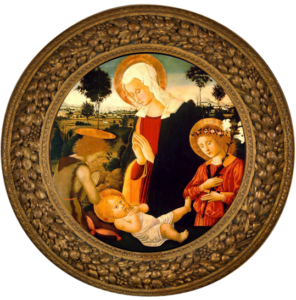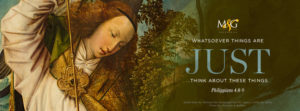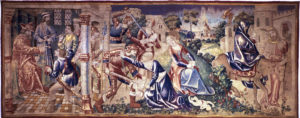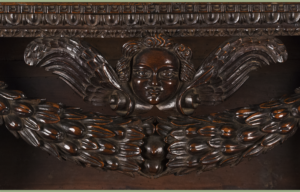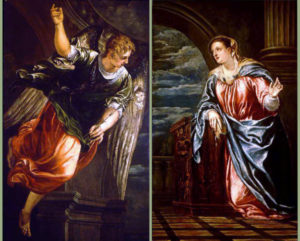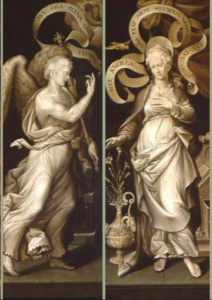Madonna and Child with St. John the Baptist and an Angel
Tempera on panel
Pseudo Pier Francesco Fiorentino
Florentine, active late 15th century
In the 15th century, Florence enjoyed a robust cultural and economic environment. One prominent idea of the era was the rediscovery of the circle and the variety of ways it was used. It may be somewhat humorous in our current culture to recognize that a simple shape could dominate life, but the circle did.
The Renaissance was about advancement—an era full of discoveries. Dias, da Gama, Columbus, and Vespucci found places previously unknown through geographical exploration of our planet, understood then to be round instead of flat. Rediscovery of Greek and Roman mathematical perfections included the circle. The shape was incorporated into architecture in a variety of public and private buildings in Florence. The circle became a symbol of God, the universe, and heaven. Between late 1430 to early 1450, artists began using the circle as part of their painting design in a format called tondo, the Italian word for round.
As a spiritual symbol, the circle became a means of representing the patron saint of Florence, John the Baptist. He was often depicted as a youth, an example to the young people of Florence. Before the Renaissance, paintings focused on individual depictions of saints and biblical characters; however, artist Fra Filippo Lippi is credited with being one of the first to paint John the Baptist together with Mary and the infant Christ in the 1450s. Additionally, Lippi was the first to paint the figures worshipping the Christ Child in adoration as seen in his work, the Annalena Adoration in the Uffizi, Florence. This new subject was the beginning of a popular focus in the late 1400s and well suited to the tondo format.
Filippo Lippi had a bustling workshop with many apprentices including Pesellino and Botticelli. As a favorite of the Medici, Lippi fulfilled numerous private and public commissions, including a Medici tondo now in the National Gallery. While Botticelli is credited with making the round format popular in the late 1400s, Lippi’s studio and apprentices created tondi and essentially mass-produced paintings depicting Mary and John the Baptist adoring the Christ Child to satisfy the public demand.
The Medici family was partly responsible for the popularity of tondi because these round paintings became not only a status symbol of wealth, but also were of spiritual significance in private, devotional settings. To have an object of art that the Medici possessed was a means of connection to them. Tondi existed in the homes of wealthy Florentines and public spaces and soon became popular in other Italian cities. They were not commonly used in churches since they were smaller.
The creator of M&G’s tondo, Madonna and Child with St. John the Baptist and an Angel, is enigmatic. Scholars have been unable to attribute a specific artist, but the work seemed influenced by Pier Francesco Fiorentino yet not painted by him. Hence, the designation of “Pseudo.” However, careful study of the work indicates that its construction predates the surge in popularity of tondi in the 1480s. M&G’s painting is one of the earliest surviving tondi produced after Fra Filippo Lippi’s initial exploration of the adoration subject—a strong representative of the Florentine tondo tradition.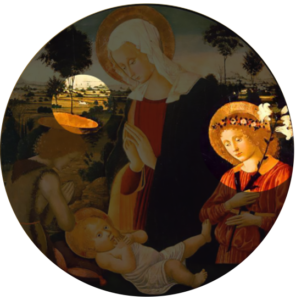
The painting’s details include a unicorn in the background, which is a symbol of Mary’s purity along with the white lily. Her adoring the Christ Child in a country landscape setting may be based on St. Bridget’s Revelations. The halos reveal the influence of naturalism prevalent in the Renaissance style. While the halos of Mary and the angel are typical of the flat Gothic style, the foreshortened, elliptical halo of John the Baptist is shown from a three-dimensional perspective.
As a “window into heaven,” M&G’s tondo has delighted viewers since entering the collection in 1951—the museum’s inaugural year.
John Good, M&G volunteer
Published 2022
